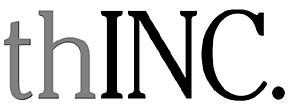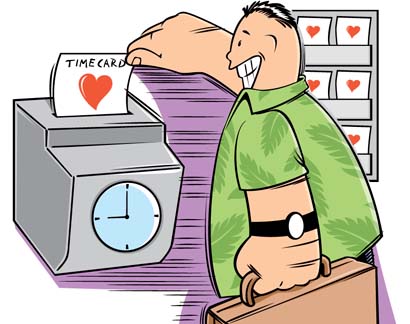

A forum for Hawaii's
business community to discuss
current events and issues

|
What’s love got
to do with it?
Having employees who love their
jobs is a win-win-win situation
I watch my neighbor across the street in awe.
When he is working on his lawn, he is meticulous, systematic and totally absorbed. No short cuts. No looking at his watch every few minutes to see if it's quitting time. No supervisors looking over his shoulders checking on his quality.
I don't know what he's like at his regular job, at his career. But I'd bet my bottom dollar that he, at the very best, is no more motivated. In all likelihood, he exhibits considerably less of a "labor of love" attitude at work. And, it is in understanding what causes that difference, and closing the gap between how many people approach their avocations versus their vocations, that you are betting your organization's bottom dollars.
Tim Sanders, senior executive at Yahoo, not only understands the dynamic described above, he had the courage in a FastCompany article (February 2002) to even label it: "The most powerful force in business is love."
Imagine that. In a rough-and-tumble, dog-eat-dog, nice-guys-finish-last world of barracudas and sharks, where even the phrase "touchy feely" is spoken with a tinge of disdain, we have a very senior executive in a very public (not to mention successful) company not only willing to use the soft "L" word, but to relate it to the very hard bottom line.
As if that wasn't enough, the "selfless promotion of the growth of others" -- the definition of love Sanders has embraced from Milton Mayeroff's brilliant book "On Caring" -- not only, as we will show shortly, serves the organization's bottom line, it is also self-serving.
It is a win-win-win.
Why three wins?
Because when you, as a leader, help others to become all they can be, you are helping them to scale the well-known Maslow hierarchy. You are propelling them toward self-actualization.
When as a result of, and in response to, your love, a person becomes the very best that they can be, your organization has to benefit, and you also grow as a direct result yourself. You have taken a step toward becoming more of the very best you can be.
Altruism has nothing to do with it!
How does the organization benefit?
Two examples should suffice: If more of your people felt that coming to work was an opportunity for a day's "labor of love," how do you think that might affect turnover? Time spent talking stink about the company or supervisors? Sickness days? Grievances filed? Doing those "little bits extra" that are not a part of people's job descriptions but, when added up, make a big difference?
Those are the easy bottom-line-related indicators. More subtle but no less important is the well-documented -- and commonsensical -- correlation between self-confidence, self-actualization and creativity. Simply put, you will get your best ideas from people who believe their bosses sincerely want them to become the best they can become.
Not sure? Ask yourself how many Ms. or Mr. Average Employees -- you know the ones: invisible, quiet, nothing special -- have you seen become non-stop fountains of creative ideas when doing volunteer work? The difference is that they are made to feel important. Valued. Needed. Not bad synonyms for the "L" word!
Okay, so how can you as a manager demonstrate that you care? It's actually as simple as ABC.
A. You increase your Awareness by asking a person what specific behavior they need from you for them to feel cared for by you.By following those three simple principles, which are outlined in my book "The ABCs of Effective Feedback: A Guide For Caring Professionals," you will quickly begin to see "what love's got to do with it" -- regardless of whether "it" is a business or a personal relationship.B. You do whatever you need to do to exhibit those specific Behaviors.
C. You periodically seek to adjust your awareness by seeking feedback on the Consequences of your behavior.
Incentives needed
to kick the oil habit
I began with the premise that the decline of global oil production is at hand, with all the economic dislocation that will entail. It is hard to overestimate the impact on our lives that the shift to a new energy economy will have.
 |
There are arguments on both sides of this issue that will keep economists wrangling for years, but global warming and Middle Eastern resource wars are problems of a magnitude that transcend economics. Legislatures here and around the country are already taking the initiative to reduce our dependency on oil.
BY JAN. 1, 2006, 85 percent of all gasoline sold in Hawaii will be required to contain 10 percent ethanol from renewable sources. To make it easier for Hawaii to supply its own ethanol, tax credits for ethanol production are now available to a maximum of $12 million a year. The current sugar cane crop in Hawaii would supply about three-quarters of the ethanol that the mandated new gasoline blend will require, and work is already under way to see how best to meet the entire demand from local sources.
Despite generous state and Hawaiian Electric Co. tax credits and subsidies for solar water heaters, about 130,000 homes still heat their water with the nation's most expensive electricity.
A state-backed loan program to help homeowners leap the hurdle of the high capital cost would help to reach much of the remaining market.
At today's price for electricity, the savings would pay back the loan in less than 10 years and provide the homeowner with net savings of a few hundred dollars a year for the future.
The same tax credits apply to other renewable technologies, including wind and solar photovoltaic power.
The credits apply also to equipment that reduces the usage of energy relying upon fossil fuel for its generation.
State agencies have been given incentives to enter into performance contracts to retrofit their buildings for energy conservation. The agencies are allowed to keep their pre-contract energy budgets as a stimulus.
Several states, including Hawaii, have enacted legislation mandating a gradually increasing component of renewables in the generation of electricity. Hawaii's Renewable Portfolio Standard calls for 15 percent renewable energy by 2015, with a goal of 20 percent by 2020.
The additional cost of the electricity, if any, will be borne by the ratepayer. But an analysis in Wisconsin of a similar law shows that the home electricity bills would increase by less than a dollar a month.
A tax credit to benefit the purchasers of fuel-efficient cars could be offset by a tax on gas guzzlers. Such a proposal died in last year's Legislature, but could be reconsidered in 2005.
As unpopular as new taxes on gasoline would be, we are paying less than half of European prices of $5.50 per gallon.
To help pay for a rail system on Oahu, a tax on gasoline would place the burden where it belongs, rather than on those who don't drive. It would also encourage fuel-efficient autos and use of an improved bus service. The alternative -- an increase in the state excise tax -- spreads the burden, but less fairly.
A tax on gasoline has the added virtue that it would encourage purchase of fuel-efficient autos and use of an improved bus service.
Hawaii's Legislature has been a leader in promoting energy conservation and the use of alternatives. However, the temptation by legislators to pick winners among the array of technologies should be avoided.
These measures, while a struggle to adopt, would add up to real progress in kicking the oil habit. By 2015, we might expect to see a reduction in oil imports of, optimistically, 25 percent. That amounts to savings of $500 million at today's prices.
Is it enough?
Probably not. By 2015, unless the rest of the world has similarly curbed its appetite for oil, the rising price of oil will swallow our savings and then some. We must plan for $100 a barrel oil in the next 10 years, and to face it unprepared will lead to economic stagnation.
Hawaii must look to its own resources of energy, wind, sunlight, geothermal power, and, especially, biofuels if we are to emerge from the coming oil crisis as strong as we are now.
To participate in the Think Inc. discussion, e-mail your comments to business@starbulletin.com; fax them to 529-4750; or mail them to Think Inc., Honolulu Star-Bulletin, 7 Waterfront Plaza, Suite 210, 500 Ala Moana, Honolulu, Hawaii 96813. Anonymous submissions will be discarded.